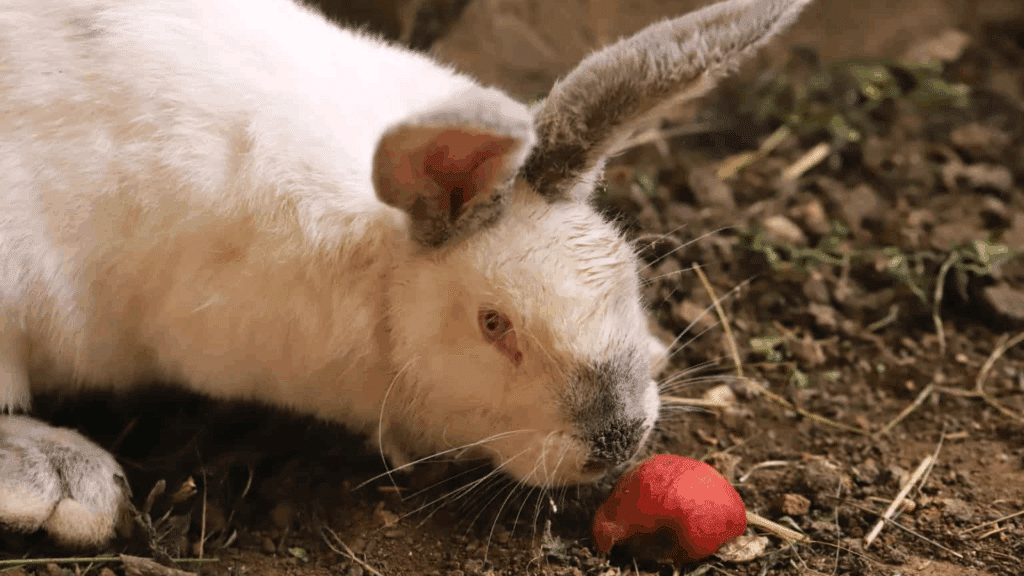Many people wonder what happens to rabbits when the weather turns cold. Do they hibernate like bears or migrate like birds?
It’s a fair question since you don’t see rabbits hopping around much in the snow. But the truth is, rabbits do neither. They face winter in their own way.
This article explains how rabbits manage cold weather through smart habits and natural instincts. You’ll learn:
- Why rabbits stay active all winter
- How wild rabbits find food and warmth
- What pet owners can do to help rabbits in the cold
By the end, you’ll see how rabbits use their thick fur, underground homes, and a little human care to stay warm and safe until spring returns.
Understanding Rabbit Behavior in Winter
When winter sets in, I’ve noticed that rabbits don’t hibernate; they stay active but change their habits to handle the cold.
They spend more time in burrows or hide under thick bushes to stay out of the wind and snow.
Since fresh greens are scarce, they eat bark, twigs, and dried plants to keep their energy up. You might see them less often, but that’s because they’re smart about saving energy and avoiding predators.
Their thick winter fur gives them enough warmth to survive chilly days and freezing nights.
Instead of moving to new areas or sleeping through the season, they adapt to their surroundings and make the best of what they have.
It’s a quiet, clever way rabbits face winter while staying alert and alive.
Do Rabbits Hibernate?

Many people believe rabbits hibernate like bears or groundhogs, but they don’t. I’ve noticed that rabbits stay awake all winter, even when the weather gets harsh.
Their bodies aren’t built for deep sleep or long periods without food. Instead, they adjust their habits to deal with the cold.
You might not see them often, but they’re still active, just quieter and more careful.
They spend extra time in burrows or under bushes, coming out mainly to search for food and stay safe. Since grass and greens are limited, they eat bark, twigs, and dried plants to get by.
Their thick fur helps them stay warm without hibernating, and they move less to save energy.
So when it seems they’ve vanished in winter, they’re really nearby, quietly adapting and surviving until spring returns.
Why Rabbits Don’t Need to Migrate?
Rabbits don’t migrate because it simply wouldn’t work for them. I’ve noticed that rabbits stay close to their home areas, usually within a few acres. Their small size and short legs make long-distance travel risky.
Moving far would expose them to predators, cold weather, and a lack of shelter.
Instead of traveling to warmer places, they adapt right where they are. They use burrows, brush piles, and thick vegetation to stay protected.
They also change their eating habits, finding bark, twigs, and dried plants when grass isn’t available.
By staying put, rabbits save energy and stay familiar with safe hiding spots. Migration just isn’t part of their nature; they survive by adjusting to winter, not running from it.
What Wild Rabbits Do in Winter?
Wild rabbits handle winter with simple instincts. They don’t hibernate or migrate; they adapt. By digging burrows and finding hidden food, they survive the cold with limited resources.
1. Digging Deeper Burrows
I’ve noticed that wild rabbits dig deeper burrows once the temperature drops. These burrows act like underground shelters, protecting them from harsh winds and predators.
The deeper tunnels stay warmer than the surface, giving rabbits a steady, safe space to rest.
They often build several entrances and exits so they can escape quickly if threatened. You probably wouldn’t spot these burrows easily; they’re hidden under bushes, trees, or snow.
Staying underground helps rabbits conserve body heat and avoid frostbite during winter’s coldest nights.
2. Lining Nests with Fur
Wild rabbits have an incredible instinct for warmth. When it gets cold, they pull out some of their own fur to line their nests, creating soft, insulated bedding.
I find this behavior fascinating; it’s a natural way to trap heat and keep their bodies comfortable in low temperatures.
Female rabbits do this more often when preparing for young, ensuring the nest stays warm and dry.
The fur lining also protects them from moisture, keeping their resting area dry even when the snow melts above. It’s a simple yet effective survival strategy.
3. Finding Food in Tough Conditions
In winter, food is scarce, but rabbits manage by eating bark, twigs, dried leaves, and roots. I’ve seen how they search near shrubs, fences, and tree trunks where food remains available.
Their sharp teeth make it easy to chew through woody plants. They also remember areas where they’ve found food before, returning there when snow covers everything else.
This smart feeding pattern helps them maintain energy without wasting effort.
Even though their diet gets rougher in texture, it provides enough nutrients to keep them active until spring brings back fresh greens.
4. Staying Warm and Alert
Rabbits rely on their thick winter coats for warmth and protection. Their fur grows denser as the season changes, acting like a natural blanket.
I’ve noticed they spend more time resting in sheltered areas and less time out in the open. This helps them save energy and stay safe from predators like foxes and owls.
They stay alert, listening for any sound of danger, ready to dart back into cover.
Even in deep snow, they move carefully, leaving small trails between shelters. Staying cautious helps them survive the harshest winter days.
Ways to Keep Pet Rabbits Warm and Safe
When winter comes, pet rabbits rely on you to stay warm and safe. They need a clean, dry, and steady space to stay healthy through the cold months.
1. Add Warm Bedding
Adding straw or thick blankets to your rabbit’s hutch is one of the easiest ways to keep them warm.
Straw traps heat better than hay and creates a soft layer to lie on. I like to pile it thickly in corners where they sleep the most.
You can also use old towels or fleece blankets for extra padding. Just remember to check the bedding daily; if it’s wet or dirty, replace it right away.
A clean, dry sleeping area keeps your rabbit warm and prevents illnesses caused by dampness.
2. Keep the Hutch Dry
Moisture is a rabbit’s worst enemy in winter. I’ve seen how quickly dampness can lower their body temperature. That’s why I always make sure the hutch is off the ground and protected from rain and snow.
Adding a waterproof cover or tarp helps keep everything dry, but make sure there’s still ventilation to avoid stuffiness.
Check the roof and sides often for leaks. Inside, use straw or absorbent bedding to soak up any moisture. A dry hutch helps rabbits maintain body heat and stay comfortable even when temperatures drop.
3. Ensure Food and Water Access
Rabbits need a steady supply of food and unfrozen water to stay healthy in winter. Cold weather increases their energy needs, so I feed them a bit more hay and fresh veggies.
Hay keeps them warm as it digests and helps maintain their digestive health.
Water bottles often freeze in outdoor setups, so I prefer heavy ceramic bowls; they’re harder to tip and easier to refill.
I check the water several times a day to be sure it’s not frozen. Regular feeding and hydration help keep your rabbit’s energy up and body warm.
4. Keep a Routine
Rabbits are creatures of habit. I’ve noticed that keeping a consistent routine helps them stay calm and comfortable. Try to feed, clean, and check on them at the same time each day.
When you spend a few minutes with your rabbit daily, you’ll quickly notice if something’s off, like shivering, cold ears, or low activity.
You can also gently feel their fur to make sure it’s dry and thick enough for the season.
A steady routine not only builds trust but also ensures you spot any cold-related issues early, keeping your rabbit safe all winter long.
Signs Your Rabbit Is Feeling Cold
Rabbits can’t tell you when they’re cold, so you have to watch for changes in their behavior and body temperature. I’ve learned that small signs can show when your rabbit needs extra warmth and care.
- Shivering or Trembling: If your rabbit shakes or trembles, it’s a clear sign they’re too cold and need immediate warmth.
- Cold Ears and Feet: Touch their ears or paws; if they feel icy, your rabbit is losing heat fast.
- Less Activity: When rabbits get cold, they move less to save energy. If yours stays still for long periods, check their temperature and bedding.
- Hunched Posture: A rabbit sitting tightly curled with fur puffed up is trying to trap heat.
- Eating or Drinking Less: Cold stress can lower appetite. Make sure food and water are always fresh and easy to reach.
- Hiding More Than Usual: Rabbits often stay tucked away when trying to conserve warmth or avoid drafts.
If you notice several of these signs, move your rabbit to a warmer, drier area and give them extra bedding or gentle warmth right away.
Conclusion
Rabbits don’t hibernate or migrate; they simply adapt. I’ve always found it impressive how these small animals handle harsh winters with such simple yet effective habits.
They dig deeper burrows, build warm nests, and find ways to eat even when the ground is frozen.
Pet rabbits do the same in their own way, relying on your care to stay warm and safe. It’s a good reminder that survival doesn’t always take something dramatic; it takes consistency and awareness.
So next time you see fewer rabbits in winter, know they’re close by, quietly getting through it.
These little survivors show us that even the smallest creatures can face big challenges and make it through, especially with a little help from their human friends.








